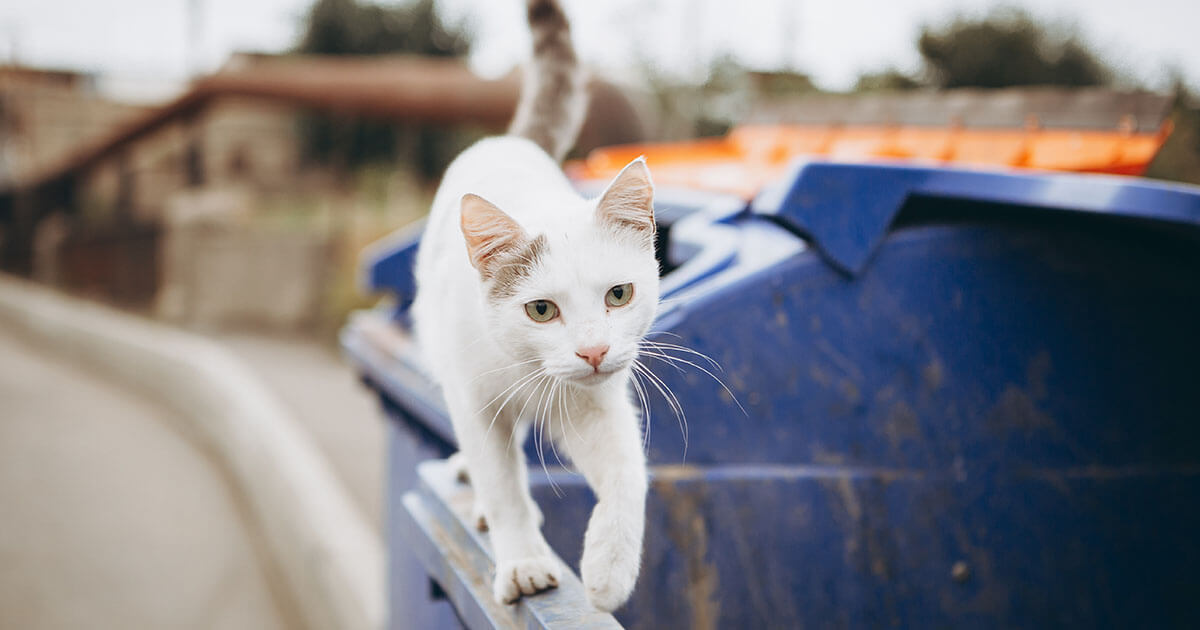Petting stray cats can be safe with caution, but risks exist. Always approach strays gently to avoid bites or scratches.
Welcoming a stray cat with a gentle pat might seem like an act of kindness, but it’s important to consider both your safety and the well-being of the animal. Stray cats, while often friendly, can carry diseases and parasites, and they may react unpredictably due to past trauma or fear.
It’s crucial to wash your hands thoroughly after any contact to prevent the spread of illness. For those who are animal lovers, the temptation to interact with a stray can be strong, but remember these cats are not accustomed to human touch and may view it as a threat. Always observe their body language: a relaxed posture and a raised tail can signal that the cat is open to interaction, while hissing or flattening ears are clear indicators that you should keep your distance.

Credit: www.factualamerica.com
The Allure And Risks Of Stray Cats
Stray cats often capture hearts with their mysterious lives and endearing behaviors. Yet, despite the temptation to greet them with open arms, potential dangers lurk. Understanding these can help ensure the safety of both humans and felines.
Temptation To Interact
The urge to befriend a stray is natural. Their soft fur and soulful eyes often draw in animal lovers. Nonetheless, it’s crucial to approach with caution due to uncertain temperaments and health statuses.
- Shiny coats and gentle purrs can mislead.
- Strays may not be accustomed to human touch.
- Safety first: Give strays space until trust is established.
Potential Health Hazards
Stray cats may carry diseases harmful to humans and other pets. These hazards necessitate careful handling.
| Disease | Transmission | Precaution |
|---|---|---|
| Rabies | Bites, scratches | Keep a distance, observe from afar |
| Feline Leukemia | Close contact | Do not touch, do not feed |
| Ringworm | Direct contact | Wear gloves, wash hands |
Protect yourself and your pets by staying informed. Ensure vaccinations are up-to-date, and consult a vet when in doubt.

Credit: www.linkedin.com
Myths Surrounding Stray Cats
Many of us have encountered a stray cat wandering around. People often hold several beliefs about them. Common myths can shape the way we interact with these furry wanderers. Let’s debunk some of these misconceptions.
All Strays Are Feral
Not all stray cats are wild. ‘Stray’ often means a cat has had a home. These cats may be lost or abandoned. Feral cats have little to no human contact. Strays can be friendly and may enjoy a soft pet. Remember, approach with care as every stray’s history is unique.
Strays Carry More Diseases Than House Cats
It’s not always true that strays are more disease-ridden than house cats. While they may lack regular veterinary care, strays might still be healthy. Be cautious nonetheless. It’s good to be informed about vaccinations and common ailments.
Consider these points next time you meet a stray:
- Not all strays are aggressive.
- Offer clean water and food cautiously.
- Consult a vet if you plan to adopt.
Understanding Feline Behaviors
Understanding Feline Behaviors is essential when considering whether it is safe to pet a stray cat. Cats, unlike dogs, often convey subtle messages through their body language. To prevent a scratch or bite, it’s crucial to read these signals accurately. By gauging a cat’s approachability and recognizing signs of aggression, individuals can engage with stray cats more safely and respectfully.
Assessing A Stray’s Approachability
It’s important to observe a stray cat from a distance before attempting to pet it. Look for signs of a relaxed posture, such as a raised tail or slow blinks. These indicators suggest the cat may be open to human interaction. Remember, each cat is unique, and patience is key.
- Quietly observe the cat’s behavior.
- Note if the cat makes eye contact and appears calm.
- Check for the cat’s openness to your presence before getting closer.
Signs Of Aggression To Watch For
Recognizing aggression in cats greatly reduces the risk of an unpleasant encounter. If a stray cat shows any of the following signs, it is best to keep your distance:
| Demeanor | Explanation |
|---|---|
| Hissing or Growling | These sounds indicate the cat feels threatened. |
| Flattened Ears | Ears laid back against the head signal agitation. |
| Swishing Tail | A rapidly moving tail means irritation or fear. |
| Dilated Pupils | Large pupils can be a sign of arousal or aggression. |
Spotting these behaviors helps predict a stray’s mood. Secure personal safety by respecting the cat’s boundaries.
Health Considerations When Petting A Stray
Stray cats may appear cuddly and in need of love, but it’s crucial to consider health risks. Before you extend your hand to pet one, it’s important to understand the health implications for both you and the animal. Strays carry diseases and parasites that can transfer to humans. Protecting yourself and the cat becomes a top priority. Know the risks and take steps to ensure a safe interaction.
Common Diseases And Parasites
Stray cats are prone to various health issues that can affect humans. Here’s what could be lurking beneath that cute exterior:
- Rabies: A deadly virus that affects mammals.
- Feline Leukemia: A virus that can weaken a cat’s immune system.
- Fleas and ticks: These can cause discomfort and carry diseases.
- Ringworm: A fungal infection that causes skin issues.
Preventing Zoonotic Transmission
To minimize health risks when interacting with strays, follow these steps:
- Wear gloves: Creates a barrier between you and potential pathogens.
- Avoid contact with bodily fluids: Pathogens can spread through them.
- Wash your hands: Do this immediately after petting a stray.
- Visit a doctor: If bitten or scratched, seek medical attention.
Remember, a stray’s health is as important as your safety. Consult a vet if you’re concerned about a stray’s health.
Best Practices For Petting Stray Cats
Encountering a stray cat can spark the desire to show some affection. Knowing the best way to do so is crucial for safety and kindness. This guide highlights safe practices for petting these feline friends.
Approach Techniques
Observe body language before moving closer. Signs of relaxation, such as slow blinking, indicate the cat may welcome contact. Extend a hand slowly towards the cat. Allow the cat to sniff and approach at its own pace. Avoid sudden movements that might startle the animal. If the cat seems receptive, gently stroke the cat’s back or the base of its ears.
Hygiene After Interaction
Sanitation is critical after petting any animal. Use hand sanitizer immediately after the interaction. Once home, wash hands with soap and water. Keep any open wounds covered to prevent infection. If there’s any concern regarding fleas or ticks, change clothes and do a full check.
- Use hand sanitizer: Before touching your face or anything else, disinfect your hands.
- Wash hands thoroughly: Use soap to eliminate germs.
- Manage clothing: Change clothes if worried about pests.
Contributing To Stray Cat Welfare
Contributing to Stray Cat Welfare is a community effort that helps friendly felines live better lives. Many stray cats seek human affection, making you wonder; is it safe to pet them? Beyond offering a gentle pat, you can play a significant part in improving their welfare. Here’s how you can help these furry friends.
Support For Local Shelters
Local shelters provide a haven for strays in need. You can support them by:
- Donating food, toys, or bedding to comfort the cats.
- Volunteering time for care and companionship.
- Helping with fundraisers to secure resources.
The Role Of Trap-neuter-return Programs
Trap-Neuter-Return, or TNR, is a humane way to help stray cats. Here’s what TNR does:
- Cats are trapped safely.
- Veterinarians neuter or spay them.
- Cats return to their outdoor homes.
This program reduces the number of new strays and keeps existing ones healthier.

Credit: www.sun-sentinel.com
Frequently Asked Questions Of Is It Safe To Pet Stray Cat
Is It Ok To Pet A Stray Cat?
Petting a stray cat can be risky due to health and behavioral uncertainties. Approach slowly, let it sniff you, and gently pet if it seems comfortable. Always wash your hands after contact.
Can I Catch Something From Petting A Stray Cat?
Yes, petting a stray cat carries risks such as transferring fleas, ringworm, or other pathogens. Always wash your hands thoroughly after contact.
Should I Wash My Hands After Petting A Stray Cat?
Yes, wash your hands after petting a stray cat to prevent potential transmission of diseases and maintain good hygiene.
Is It Hygienic To Pet Stray Cats?
Petting stray cats isn’t always hygienic; they can carry diseases. Always wash your hands thoroughly after handling them to reduce health risks.
Conclusion
Approaching stray cats requires caution and respect for their wellbeing. Ensure your safety first, and assess the cat’s behavior. Seek advice from animal experts before interaction. Remember, a kindly gesture goes a long way, but always prioritize mutual safety. Encounters with strays can be heartwarming if handled correctly.

